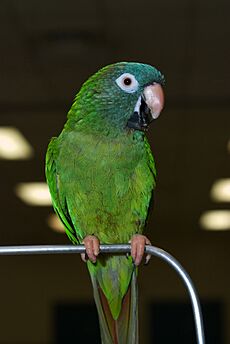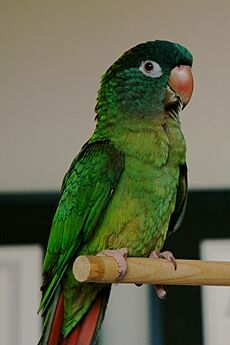Blue-crowned parakeet facts for kids
Quick facts for kids Blue-crowned parakeet |
|
|---|---|
 |
|
| Thectocercus acuticaudatus neumanni in San Isidro in Bolivia |
|
| Conservation status | |
| Scientific classification | |
| Genus: |
Thectocercus
|
| Species: |
acuticaudatus
|
 |
|
| Synonyms | |
|
Aratinga acuticaudata |
|
The blue-crowned parakeet is a small, bright green parrot. It is also known as the blue-crowned conure or sharp-tailed conure. This bird has a blue head and a light-colored beak. You can find these parrots in many parts of South America. They live from eastern Colombia all the way to Curacao in the southern Caribbean. They also live in the northern areas of Argentina.
Blue-crowned parakeets like to live in open areas like savannas. They also enjoy woodlands and the edges of forests. However, they stay away from thick, wet forests like the Amazon. Bird experts often call this bird a parakeet. But people who keep birds as pets usually call them conures.
Contents
About the Blue-Crowned Parakeet
The blue-crowned parakeet is the only species in its group, called a genus (Thectocercus). But there are five different types, or subspecies, of this bird:
- Thectocercus acuticaudatus acuticaudatus
- Thectocercus acuticaudatus haemorrhous
- Thectocercus acuticaudatus koenigi
- Thectocercus acuticaudatus neoxenus
- Thectocercus acuticaudatus neumanni
These birds used to be grouped with other parrots in the Aratinga genus. But scientists studied them closely. They found that the blue-crowned parakeet was different enough to have its own special group.
What They Look Like
The blue-crowned parakeet is a medium-sized bird. It is about 37 cm (15 in) long. It usually weighs between 140 and 190 g (4.9 and 6.7 oz).
These birds are mostly green. They have a dull blue color on their forehead, the top of their head, cheeks, and ears. Some types of these birds have less blue. They have a white ring of skin around each eye. In some wild birds, this ring is bright orange-yellow.
Their chest feathers are usually green or yellow-green. When their wings are closed, they match the body color. But when they open their wings, you can see blue-brown feathers. The outer flight feathers are chestnut brown. Their tail feathers are green on top. Underneath, they are maroon or red-brown. In bright light, they can look bright orange and scarlet.
Their legs are pink-brown with grey-brown claws. The top part of their beak is horn-colored. It tapers to a sharp, grey-black tip. Young birds in some areas have a horn-colored lower beak. This changes to grey-black by their second year. Other types of these birds keep the horn-colored lower beak their whole lives.
How They Raise Their Young
Blue-crowned parakeets make their nests in holes in trees. The female bird lays white eggs. Usually, there are three or four eggs in a nest. The female sits on the eggs for about 26 days to keep them warm. After the chicks hatch, they stay in the nest for about 52 days. Then they are ready to fly out on their own.
Blue-Crowned Parakeets as Pets
Many people call blue-crowned parakeets "blue-crowned conures" when they are kept as pets. These birds are very social. They can also learn to talk quite well compared to other conures. They have become popular pets because they are often seen as "easier" parrots to care for.
However, these birds are also very smart and have a lot of energy. They need a lot of attention from their owners. They also need a large cage with plenty of room and toys to play with. Sometimes, they can be quite loud. Because of this, they are best for people who are serious about caring for birds.
In Movies
- A blue-crowned conure was the main star of the family movie Paulie. The film used 14 different birds to play the role!




